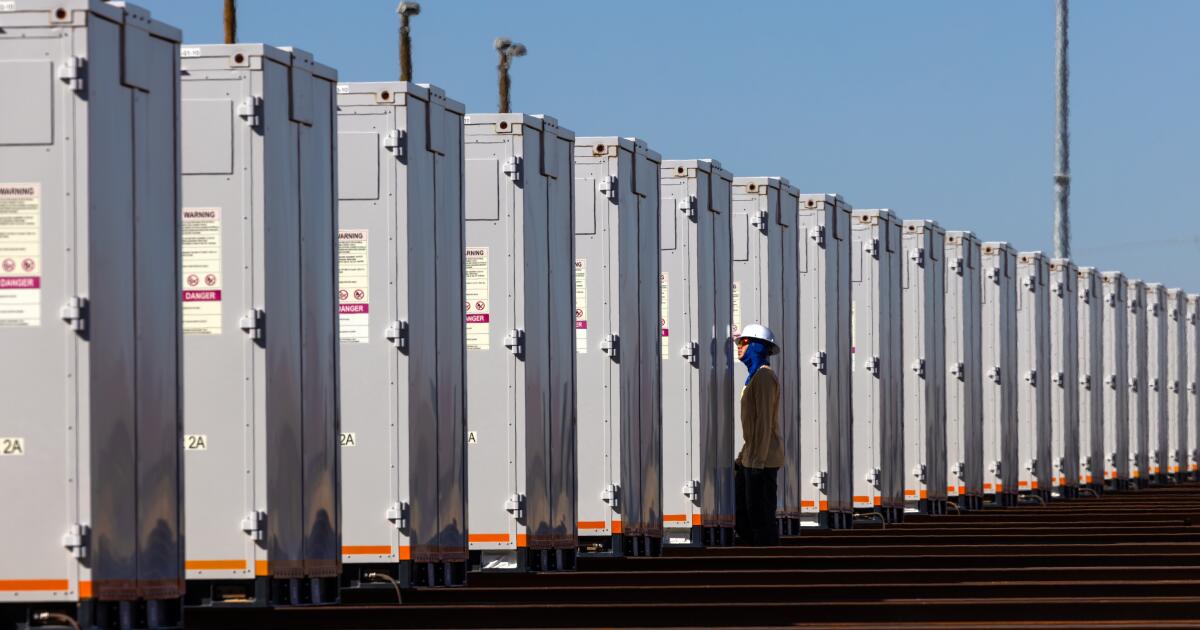California added 1,200 megawatts of battery energy storage to its electrical grid over the last six months, further building on its nation-leading capacity and pushing the state closer to its clean energy goals, officials said Thursday.
Gov. Gavin Newsom announced the latest milestone while making the rounds at the United Nations Conference of the Parties climate summit in Belém, Brazil, where he is touting the state’s international climate leadership amid the notable absence of officials from the Trump administration.
With the latest additions, the Golden State has reached 16,942 megawatts of available battery storage — about one-third of the estimated capacity needed to reach its goal of 100% clean energy by 2045.
Battery energy storage systems capture excess wind and solar power and push it onto the grid during hours of peak demand, or when the sun isn’t shining or the wind isn’t blowing.
Newsom used the announcement as an opportunity to swipe at President Trump, who has focused heavily on the growth of fossil fuels such as oil, gas and coal while simultaneously slashing funding for renewable energy projects in California and across the U.S.
“Donald Trump’s reckless energy agenda puts China first and America last — letting Beijing seize the global clean energy economy and the good-paying jobs, manufacturing, and economic prosperity that come with it,” the governor said in a statement. “California won’t stand by and watch.”
While China continues to burn fossil fuels, the country is breaking global records with its investments in renewable energy and battery storage. In 2024, China commissioned 37 gigawatts of battery storage, more than the combined additions of the U.S. and Europe, according to the energy think tank Ember.
But battery storage has also been transformative for California, helping the state avoid rolling blackouts and urgent calls for energy conservation, known as Flex Alerts, in the last several years. California now has more installed battery capacity than any other jurisdiction on the planet except for China, according to Newsom.
“We now dominate,” he said at a climate investors event in São Paulo on Monday before heading to Belém.
Experts say the state’s gains are impressive. The U.S. has about 37 gigawatts of total operating battery capacity, nearly half of which is in California, said Maia Leroy, founder of the energy consulting firm Lumenergy LLC.
“California is claiming a huge victory here,” Leroy said. She said the state’s capacity of 16,942 megawatts — or 16.9 gigawatts — is enough to power about 13 million homes for four hours, the typical duration of a battery.
The surge in storage is meeting with even faster growth of solar in the state. Together, solar plus batteries have eliminated more than 37% of fossil gas use on the state’s main grid, the California Independent System Operator, in just the last two years, according to Mark Z. Jacobson, a professor of civil and environmental engineering at Stanford University.
“That is an enormous amount of batteries,” Jacobson said.
Energy storage is one of many ways California is hoping to stand out at this year’s COP summit. Representatives from the state — including Newsom, California Natural Resources Secretary Wade Crowfoot and Air Resources Board Chair Lauren Sanchez — have also entered into several partnerships and agreements with other regions and nations this week.
Among them is the Global Energy Storage and Grids Pledge, an initiative started at last year’s COP conference that sets a global target of deploying 1,500 gigawatts of energy storage and building about 15.5 million miles of new transmission infrastructure by 2030. California became the first subnational entity to join the pledge, which has been backed by more than 100 countries and organizations.
The pledge is a good start, but the world needs more than just storage and transmission, Jacobson said.
“California is moving faster than the U.S. as a whole, but to really make inroads, California needs to also electrify transport, industry and buildings as fast as it is building batteries, while growing offshore wind, utility solar, rooftop solar and enhanced geothermal,” he said.
The state is working toward those goals, including pushing forward with a major offshore wind project that lost nearly half a billion dollars in federal funding from the Trump administration this year.
Other agreements signed at COP so far this year include joint partnerships and memoranda of understanding with Colombia, Chile, Nigeria, the Brazilian state of Pará and the German state of Baden-Württemberg on issues such as wildfire prevention and response, sustainable urban transportation and greenhouse gas emission reductions.
Times staff writer Melody Gutierrez contributed to this report.
This story originally appeared on LA Times

